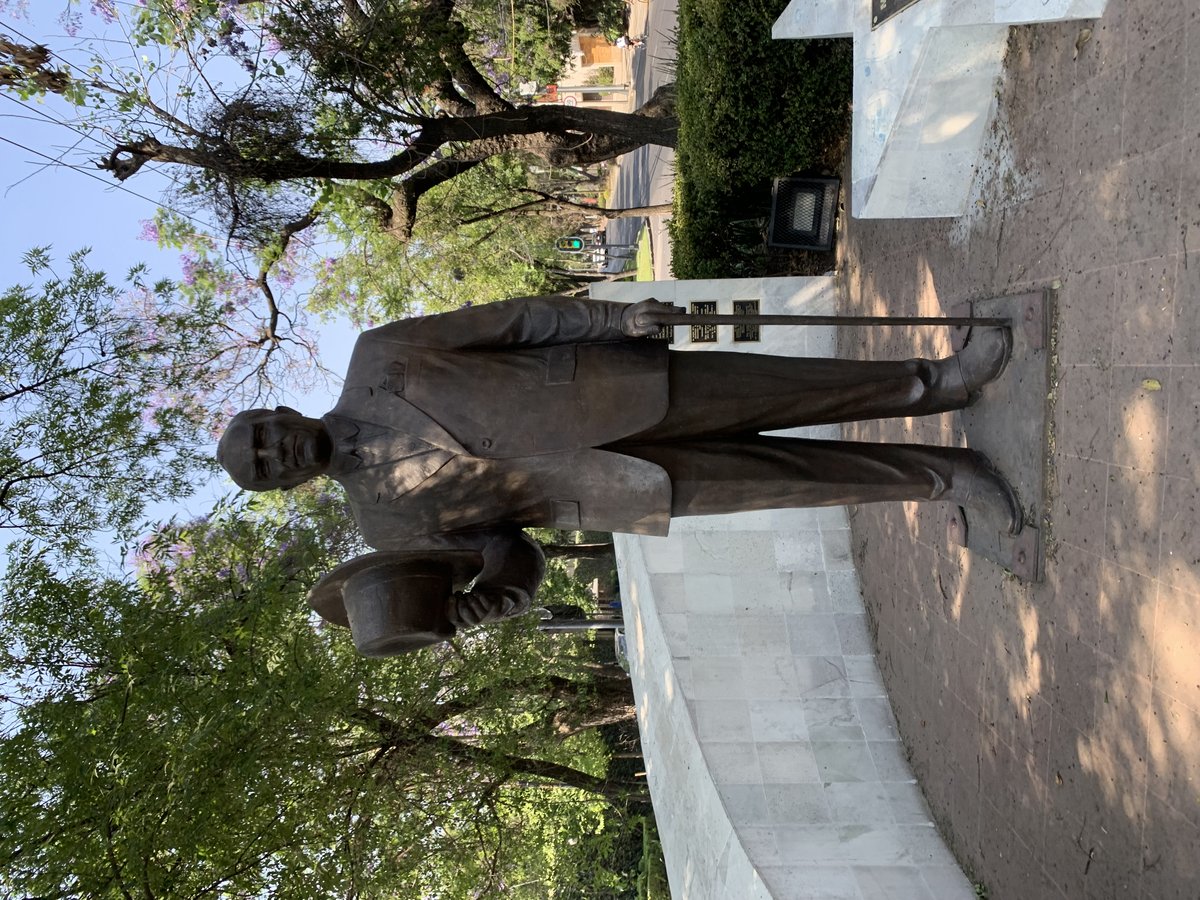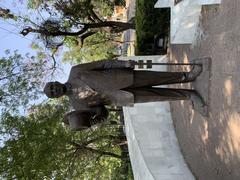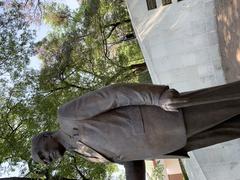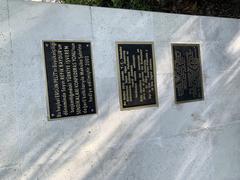
Mustafa Kemal Atatürk Monument Mexico City: Visiting Hours, Tickets, and Historical Significance
Date: 14/06/2025
Introduction
The Mustafa Kemal Atatürk Monument in Mexico City stands as a profound tribute to the founder of modern Turkey and a symbol of the enduring diplomatic and cultural ties between Turkey and Mexico. Unveiled on October 29, 2003—coinciding with the 80th anniversary of the Republic of Turkey—the monument is not only a commemoration of Atatürk’s transformative leadership but also a celebration of shared values such as secularism, modernization, and international friendship. Located on the prestigious Paseo de la Reforma, this monument is a testament to the global reach of Atatürk’s legacy and an invitation for visitors to reflect on visionary leadership and cross-cultural dialogue (webot.org; MexicoCity.cdmx.gob.mx; visitturkey.in).
Table of Contents
- Origins and Commissioning
- Artistic Features and Symbolism
- Historical Context and Global Legacy
- Inauguration and Diplomatic Importance
- The Monument’s Urban Context
- Visitor Information: Hours, Tickets, Accessibility
- Nearby Attractions and Practical Tips
- Cultural and Educational Impact
- Preservation and Community Engagement
- Frequently Asked Questions (FAQ)
- Visual Resources and Media
- Additional Resources and Related Links
- Summary and Recommendations
Origins and Commissioning
The Mustafa Kemal Atatürk Monument was the result of a collaborative effort initiated by the Confederation of Employers’ Unions of Turkey (TÜRK-İŞ). The project, conceived in the late 1990s, aimed to honor Atatürk’s influence beyond Turkey and reinforce international bonds. Azerbaijani sculptor Səid Rüstəm was chosen for his expressive yet dignified approach, and the monument was completed in 2000. Its inauguration took place three years later, symbolically aligned with the founding date of the Turkish Republic (webot.org).
Artistic Features and Symbolism
Design and Structure
The monument, prominently displayed on Paseo de la Reforma, features a 3.2-meter bronze statue of Atatürk. Behind the figure, a striking white marble crescent and star—borrowed from the Turkish flag—serves as a luminous backdrop, representing purity, peace, national pride, and enlightenment (MexicoCity.cdmx.gob.mx). The combination of durable bronze and radiant marble not only ensures longevity but also enhances the monument’s visual appeal.
Iconography
Atatürk’s pose conveys vision and determination, while the crescent and star evoke Turkey’s republican ideals. Inscriptions in Turkish and Spanish, including Atatürk’s maxim “Peace at Home, Peace in the World,” underscore the universality of his message.
Historical Context and Global Legacy
Mustafa Kemal Atatürk (1881–1938) is celebrated as the architect of modern Turkey. His reforms in education, law, language, and governance laid the foundation for a secular and progressive nation-state. The decision to honor Atatürk in Mexico City reflects the shared experiences of revolutionary change and mutual respect between Turkey and Mexico, both nations committed to secular governance and modernization.
The Mexico City monument is part of a global network of Atatürk memorials, echoing the presence of Anıtkabir in Ankara and reinforcing his worldwide influence (Wikipedia: Monuments and memorials to Mustafa Kemal Atatürk; visitturkey.in).
Inauguration and Diplomatic Importance
The unveiling on October 29, 2003, was attended by Turkish and Mexican dignitaries, including high-ranking ministers. The date, Republic Day in Turkey, heightened the event’s symbolic significance and highlighted the monument as a gesture of international friendship (webot.org). The presence of officials from both nations underscored the monument’s diplomatic and cultural relevance.
The Monument’s Urban Context
Paseo de la Reforma is renowned for its collection of international statues, reinforcing Mexico City’s cosmopolitan identity. The Atatürk Monument is situated among tributes to world leaders like Mahatma Gandhi and Winston Churchill, placing Atatürk within a global pantheon of reformers and statesmen. Its location, near embassies and cultural sites, enhances the city’s multicultural landscape (enjoytravel.com).
Visitor Information: Hours, Tickets, Accessibility
- Location: Paseo de la Reforma, at the intersection with Avenida Presidente Masaryk, Polanco district.
- Visiting Hours: The monument is accessible 24/7 as it stands in an open public plaza. Daylight hours are recommended for the best experience.
- Admission: Free of charge; no tickets required.
- Accessibility: The monument is fully wheelchair accessible, with paved pathways and ramps.
- Transport: Easily reached via Mexico City Metro (stations: Auditorio or Polanco, Line 7) and multiple bus routes. Limited street parking is available, but public transport is advised.
Nearby Attractions and Practical Tips
- Chapultepec Park: A vast urban park with museums and the historic Chapultepec Castle.
- Museo Nacional de Antropología: World-class exhibits on pre-Columbian cultures.
- Avenida Presidente Masaryk: Premier shopping, dining, and nightlife.
- Angel of Independence: Another iconic Reforma monument, ideal to pair with your visit.
Best Times to Visit: Early mornings or late afternoons provide pleasant weather and optimal lighting.
Safety and Etiquette: The Polanco area is safe and well-patrolled. Maintain a respectful demeanor, especially during commemorative events. Photography is allowed; drone use requires advance permission.
Cultural and Educational Impact
The monument is a focal point for the Turkish community and a site for cultural diplomacy, particularly on Turkish national holidays. It serves as an educational resource, with plaques and inscriptions offering insight into Atatürk’s reforms and philosophy. School groups, tourists, and history enthusiasts benefit from its accessible information and cross-cultural significance (visitturkey.in).
Preservation and Community Engagement
The monument is maintained through collaboration between local authorities and the Turkish Embassy, ensuring its upkeep and relevance. Occasional public events, guided tours (as part of broader city tours), and cultural festivals promote ongoing engagement and awareness of Atatürk’s legacy.
Frequently Asked Questions (FAQ)
Q: What are the visiting hours of the Mustafa Kemal Atatürk Monument?
A: The monument is accessible to the public 24/7, though daylight hours are best for visiting.
Q: Is there an entrance fee?
A: No, visiting the monument is free of charge.
Q: Is the site wheelchair accessible?
A: Yes, it features paved paths and ramps.
Q: Are there guided tours?
A: No dedicated tours, but some city tours include it as a stop.
Q: How do I get there?
A: Use Metro Line 7 to Auditorio or Polanco stations, or take a taxi/rideshare.
Visual Resources and Media
For the best visitor experience, explore high-resolution photographs showcasing the monument’s bronze statue and marble crescent and star, ideally during the morning or evening for optimal lighting. Interactive maps and virtual tours (if available) can help plan your visit. Use descriptive alt text for images: “Mustafa Kemal Atatürk Monument Mexico City,” “Atatürk Monument Paseo de la Reforma,” etc.
Additional Resources and Related Links
- Mustafa Kemal Atatürk Monument, Mexico City, webot.org
- Atatürk Monument on Paseo de la Reforma, MexicoCity.cdmx.gob.mx
- Anıtkabir, Ankara, visitturkey.in
- Famous Monuments in Mexico City, enjoytravel.com
- Anıtkabir – A Monument of Legacy and Reverence, theothertour.com
Summary and Recommendations
The Mustafa Kemal Atatürk Monument in Mexico City is more than a physical tribute—it is a living symbol of modernity, peace, and international collaboration. Its prominent location, dignified artistry, and educational value make it an essential stop for anyone interested in global history or exploring Mexico City’s rich cultural landscape. The monument’s accessibility, free admission, and proximity to other major sites enhance its appeal for both locals and tourists.
To make the most of your visit, consider using interactive tools or guided city apps such as Audiala. Immerse yourself in the story of Atatürk and the ideals that connect nations across continents.













































































































































































